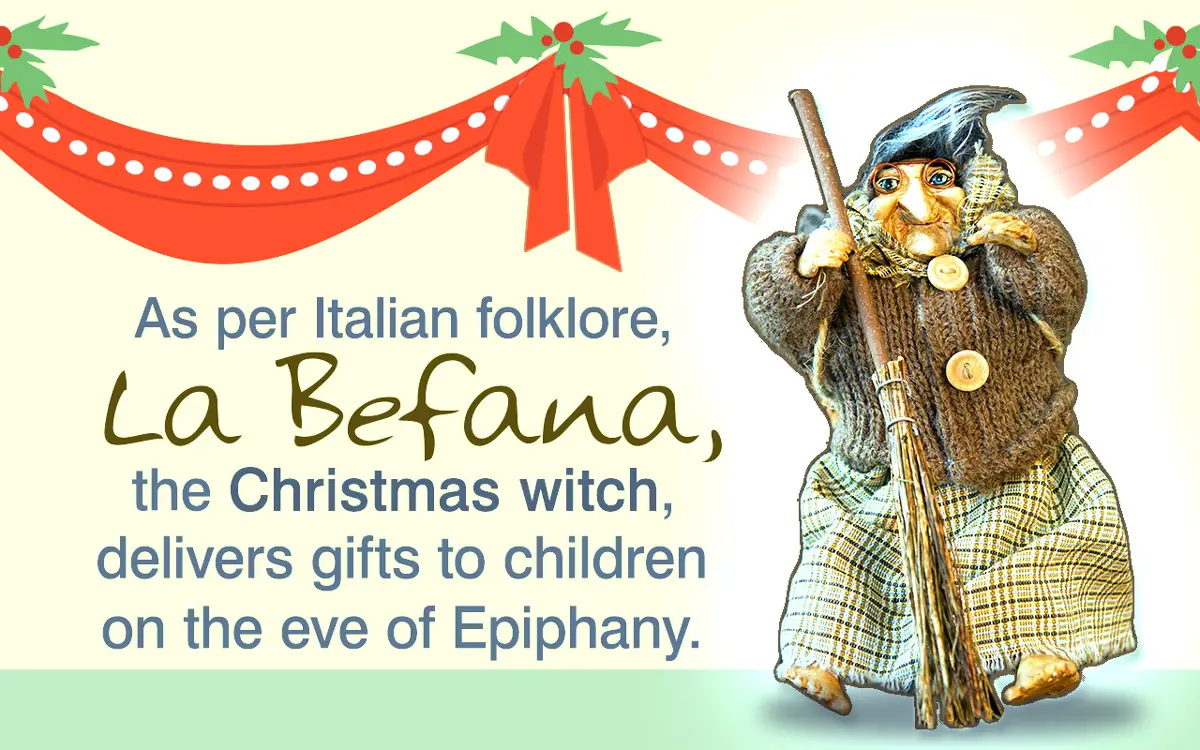Traditional Italian Christmas Customs
Traditional Italian Christmas Customs
Did you ever feel like Christmas being celebrated for just one day is not enough? Well, then you should definitely adopt Italian Christmas customs, where the entire celebrations last for more than three weeks. Yes, that’s right, three whole weeks! And did you know that Christmas was actually ‘invented’ in Italy? Italian Christmas customs are a festive blend of Christian influences and pagan celebrations. If you want to explore global holiday traditions and incorporate some old-world charm into your holiday, then it would probably be a good idea to start by learning more about Italian Christmas customs.
History
Christmas, as it is celebrated in Italy, has two origins – the familiar Christian traditions and the pagan traditions from the ancient Roman empire. In ancient times, ‘Saturnalia’ was celebrated between the 17th of December and the 24th of December, and was the pagan festival in honor of the Roman God, Saturn. During this ancient ritual, cattle were slaughtered so they would not have to be fed during the long winter. For most people, especially peasants, it was the only time of the year with an abundance of fresh meat available. With all the extra food and fermented ale, the timing was perfect for a celebration! In 4 A.D. the date for the birth of Jesus Christ was officially set as the 25th December by the church in Rome. Eventually, this day was recognized around the world as the official day of Christmas. Natale (Christmas), is literally understood as ‘birthday’, in Italian.
Popular Customs
Christmas in Italy is a grand affair with lots of celebration, family get together, and of course, plenty of delicious food. The celebration officially starts on 8th December, which is the L’Immacolata Concezione or the Immaculate conception, and the official end of Christmas is on 6th January which is the Epiphany. La Festa dell’Epifania is when the ‘Three Kings’ were believed to have reached baby Jesus.
The Pifferari
During the novena, Italian children recite Christmas passages, while going from one house to another. In return, people gift coins to children to buy candies. A beautiful and melodic, but rapidly disappearing Christmas tradition in Italy is the ushering in of the coming festivities by the Pifferari or fifers. They descend from the mountains of the Abruzzo and Latium, playing inviting and characteristic tunes on their bagpipes, filling the air with anticipation for the joyous celebration to come.
The Presepio (Nativity Scene)
Another popular tradition is preparing a detailed nativity scene, also known as the Presepio (or Presepe). Just like every household has to have a Christmas tree, similarly, every Italian household has to have their own unique presepio. The cribs can be as detailed or as small as you want and are usually handed down from one generation to other. The crib always contains the figurines of Mary, Joseph, and Jesus Christ along with a donkey and an ox. These figures are generally made of wood, clay, or plaster. Throughout Italian towns and cities, presepios are displayed everywhere. Many cathedrals often feature life-size figures.
The Ceppo
As per customs, a Christmas decoration staple in Italian homes is the Ceppo, which is a pyramid structure designed to hold shelves full of different Christmas items. The ceppo generally holds Christmas gifts on one shelf, while candies on the other. It is also possible to have a small nativity set with candles and pictures on one shelf. A star is placed on top of the ceppo, and ribbons, colored streamers, and glittering ornaments are hung around the frame.
The Yule Log
An Italian tradition which is an instance of the blending of pagan and Christmas is called the burning of the Yule log, which must keep burning until New Year’s Day. Through this, the pagan belief wants to explain the purifying power of fire, because of which, all evils are demolished. Ancient Christian fables say how Virgin Mary entered homes of people and warmed her newborn child before a burning log – all this, while the parents were away for Midnight Mass.
La Befana
Did you know that unlike a traditional Santa Claus, Italian customs actually have an old witch flying on a broom, known as La Befana, who leaves toys for children during epiphany? On Christmas Eve, children set their shoes by the fireplace, to be filled with small gifts and candy by La Befana. According to legend, the three wise men stopped at the home of La Befana, seeking directions. They invited her to go with them and meet Jesus, but she refused. Later that evening, she changed her mind. Gathering up toys from her own child, who had died, she flew off to meet Jesus. However, she lost her way, and has been flying ever since. On Christmas Eve, she stops at every child’s house and leaves a Christmas gift, just in case Jesus is there.
Italian Christmas Food
Of course just like any other Christmas celebration, festival in Italy cannot be complete without food or rather a feast. In Italy, many people fast for 24 hours just before the Christmas day. On Christmas day, the fast is broken by having a meal together with the family. Today, not everyone may fast, however, some people skip eating meat on Christmas day. This is the reason that fish is so popular for a traditional meal. The main course for food is fish, eel, lamb, or turkey. Accompanying the main course is usually antipasto, cheese and crackers, pasta with various sauces, shellfish, sausage, vegetables, and potatoes. As a part of Christmas recipes, desserts consist of pandoro which is a sweet yeast bread, candied fruit, gingerbread, panforte (similar to fruitcake), Panettone, and candied nuts. Honey was served during this time in ancient Rome, so that the new year would be ‘sweet’ for people.
In the middle of the merrymaking and religious fervor, long and slim candles, also called Christmas tapers, are lit and a banquet is spread. In Rome, the traditional dish on the eve of Christmas is a big female eel (Capitone), while in the Northern side of Rome, the traditional dishes may include pork (usually its legs stuffed with sausages), turkey with chestnut stuffing, etc.
You can incorporate some parts of these interesting traditions and customs to make this Christmas even more special. One tradition that you should definitely try to include is that, instead of writing letters to Santa Claus, Italian children write special letters to their parents thanking them and expressing their love! Isn’t it lovely? Merry Christmas!
This site contains product affiliate links. We may receive a commission if you make a purchase after clicking on one of these links.


